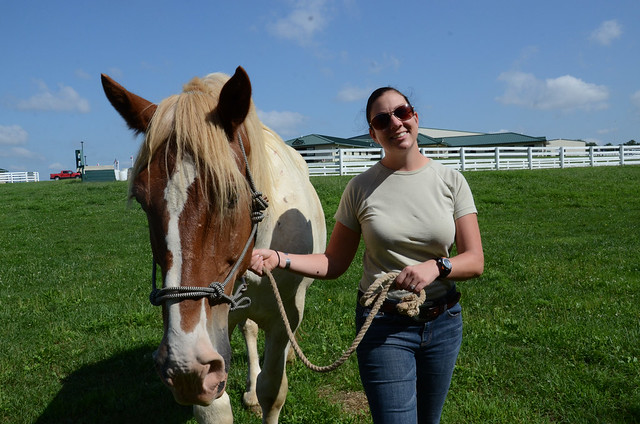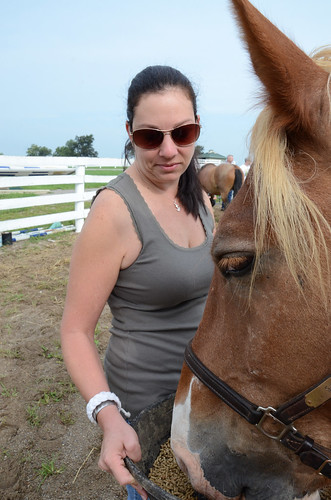This is part I of a three-part series on the Kentucky National Guard's Resiliency Training Assistant Course conducted for Guardsmen returning from deployment.
Commentary by Sgt. 1st Class Gina Vaile-Nelson
[caption id="" align="aligncenter" width="571"]

Sgt. 1st Class Gina Vaile-Nelson walks with Sargent at the Central Kentucky Riding for Hope center in Lexington, Ky., Aug. 13, 2014. As part of the Kentucky National Guard's Resiliency Training Assistant course, Soldiers are introduced to therapeutic activities with horses. (U.S. Army National Guard photo by Sgt. Brandy Mort)
LEXINGTON, Ky. -- When you’re blindfolded, turned around five times and handed the lead rope to a 1,300-pound American Draft horse, your heart will pound so loud that it ends up practically in your throat. Your other senses take over. The distinct smell of hay, manure and leather will hit you like a ton of bricks. You feel the ground, every shake from the stomp of a hoof, every uneven pebble, pile of unmentionables, straw of hay in the arena. You’ll hear the woosh of each breath that enters his nostrils, fills his lungs then releases. You’ll match his breath, which sounds just as loud as his. You’ll feel the wind at your face, the fly that bounces from his mane to your ear. Everything becomes clear.
It’s an exercise in trust. Between me and Sargent – the 1,300-pounder who could break my foot with one wrong step.
http://youtu.be/R3LXVecBQIM
It’s an exercise in listening. Of the directions Sgt. Brandy Mort calls out to lead me through cones, around barrels, over jumps and into a hula-hoop.
It’s an exercise in self. Focusing on just the task at hand, not worrying about the e-mails I’m missing, the family drama I’d just experienced, the memories of a 10-month deployment or who I’m going to pick for my fantasy team.
It’s resilience.
As Soldiers, we train for combat; the worst case scenario is always present in the back of our minds. We’re high strung, but that’s a good thing because we need to be. Survival is key, mission success is essential.
But when the mission ends and the welcome home party subsides, the life we left prior to deployment starts again. Sometimes it’s changed so drastically we seem lost in our own homes. As our battle buddies readjust to their own lives, even they become distant because the team isn’t together 24/7. It seems that the puzzle pieces just don’t fit because they came out of different boxes.
But in case you forgot, it’s okay to come from different boxes. Sometimes we forget that. As leaders, it’s imperative to recognize our Soldiers, their backgrounds, their needs. And when we see that a Soldier needs to reassess and regroup, it’s our job to provide every resource possible to make that Soldier successful on the home front and within our ranks.
[caption id="" align="alignleft" width="235"]

Sgt. 1st Class Gina Vaile-Nelson feeds Sargent at the Central Kentucky Riding for Hope center in Lexington, Ky., Aug. 12, 2014. Principles discussed throughout the resiliency training was applied with daily interaction with the horses to help Guardsmen achieve their maximum potential. (U.S. Army National Guard photo by Sgt. Brandy Mort)
The Kentucky National Guard’s Resiliency Program isn’t your average cookie-cutter class. It’s an outside-the-box course that combines instruction in basic resilience principles designed to increase a Soldier’s effectiveness and well-being to develop and enhance their leadership potential. It focuses on self-awareness and regulation, connections and character strengths to help participants grow and thrive in the face of challenges and bounce back from adversity.
While thousands of Soldiers across the globe are required to train using this approved University of Pennsylvania program, no other program in the Army uses horses on a daily basis through the course to reinforce the principles and capitalize on the lessons learned in a classroom setting. That’s what makes Kentucky’s program unique – what helps us to maintain that Unbridled Service and commitment to our Soldiers well-being.
The Central Kentucky Riding for Hope program partnered with the Kentucky National Guard Resilience Program in 2012, using equine therapy to help Guardsmen deal with emotions of internal conflict, personal relationships, mental agility and character strengths. Every principle discussed throughout the training is applied with daily interaction with the horses to help Guardsmen achieve their maximum potential.
It’s a program that leaders at every level should, and do support. Though resilience training is a quarterly requirement at the unit level, the one-week course held at the Kentucky Horse Park is something that the Kentucky National Guard Resiliency Team opens up throughout the year to Soldiers and leaders.
Its goal is to help Kentucky Guardsmen who are in need. It’s more important now than ever. There are reports of 22 veterans committing suicide every day. The program is another tool to spread awareness and provide knowledge to Guardsmen on how to tap into their own strengths to become better communicators and better leaders in their unit, the community and for their Family.
On that particular day, my goal was to not be stepped on. But that didn’t happen. Sargent got me. Instead of trying to lead him, I should’ve been next to him. It’s a humbling moment when 1,300 pounds comes landing on your heel. It wasn’t Sgt. Mort’s directions or Sargent trying to get ahead. It was me, getting ahead of myself, of Sargent, of Sgt. Mort.
I didn’t drop the lead, pull off my blindfold and stomp away with my pride degraded. I regrouped, stood beside Sargent and walked with him through the next obstacle. I finished the task at hand and thanked Sgt. Mort for her solid directions and communication skills. And I praised Sargent for his ability to follow my misguided movements and judgments.
Then, as a leader I understood.